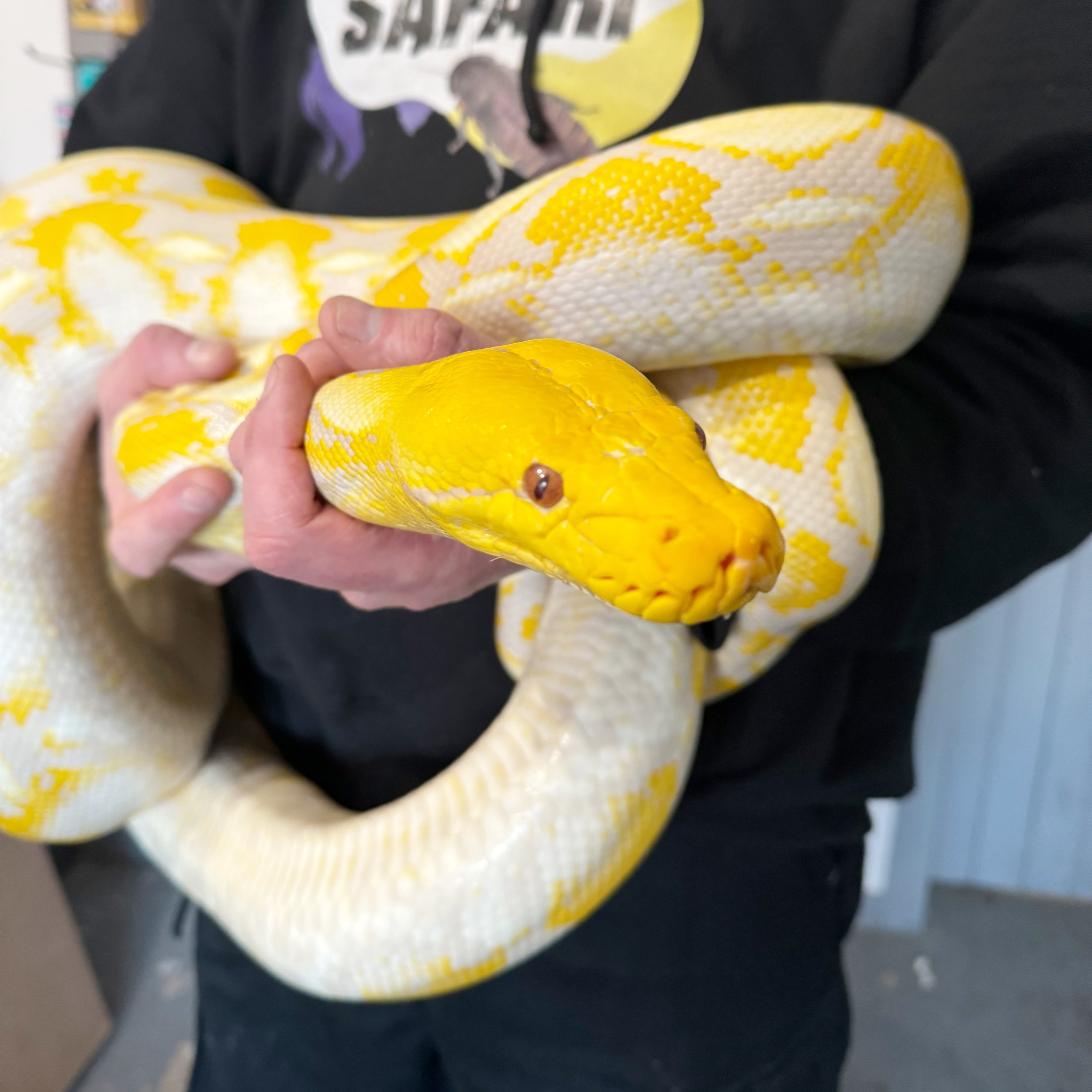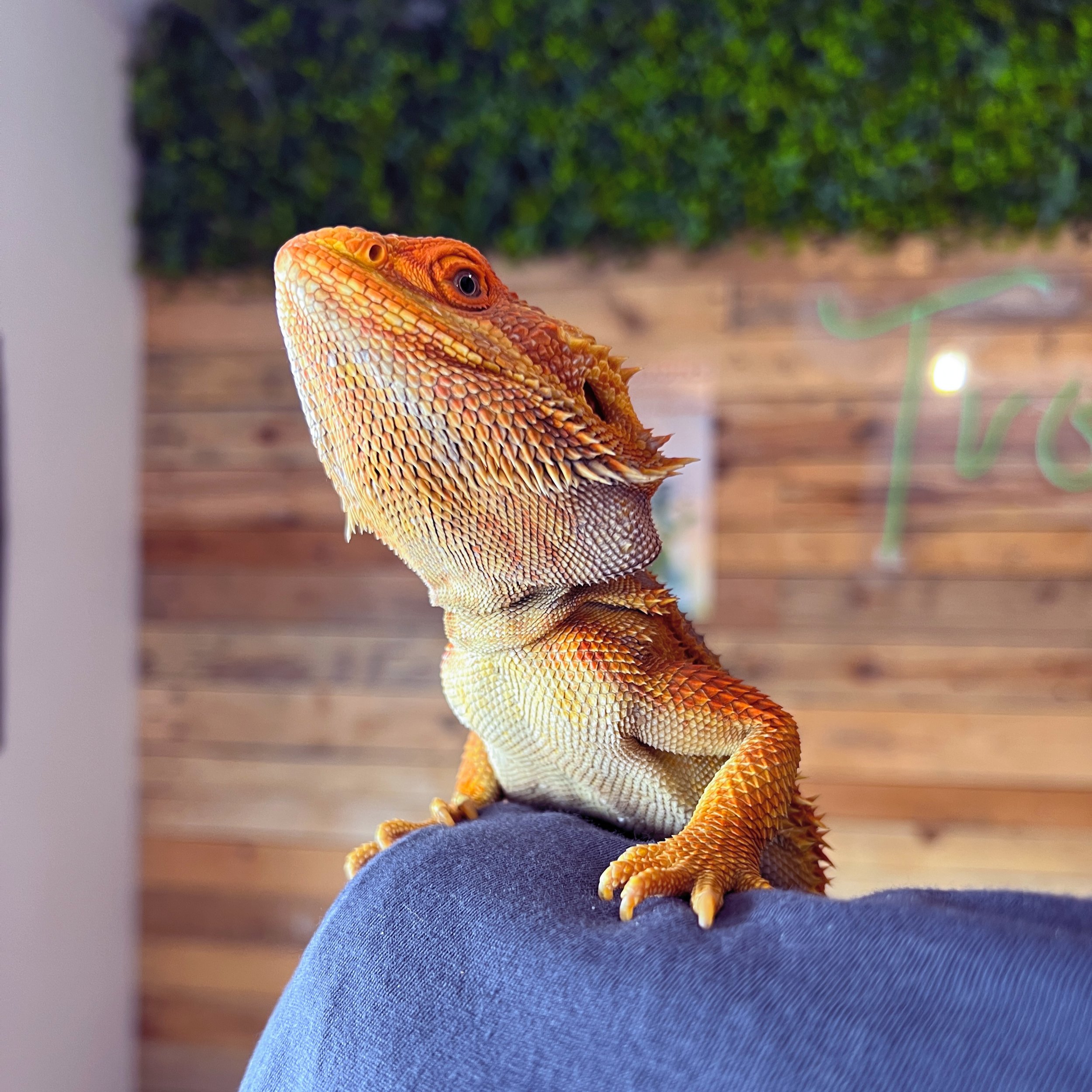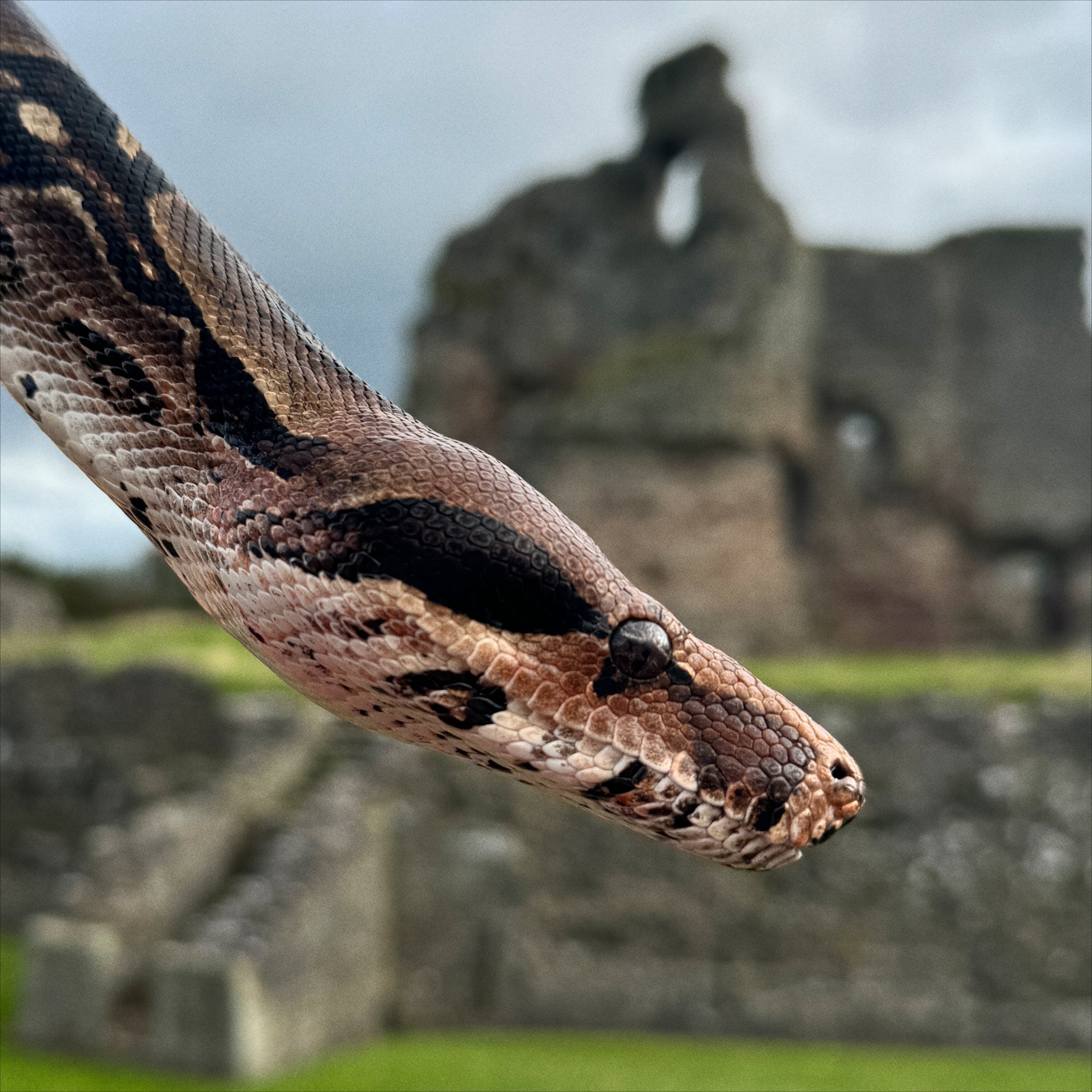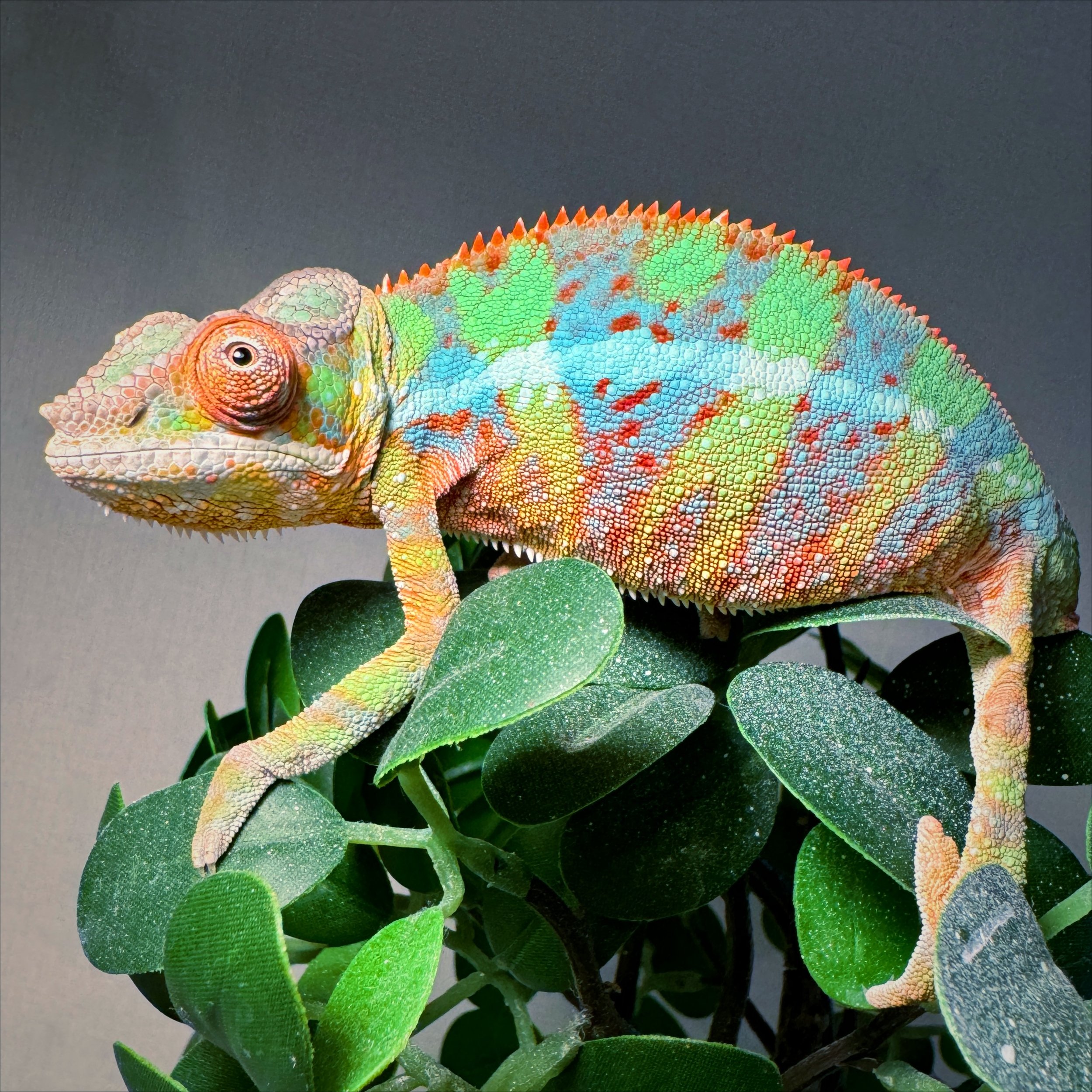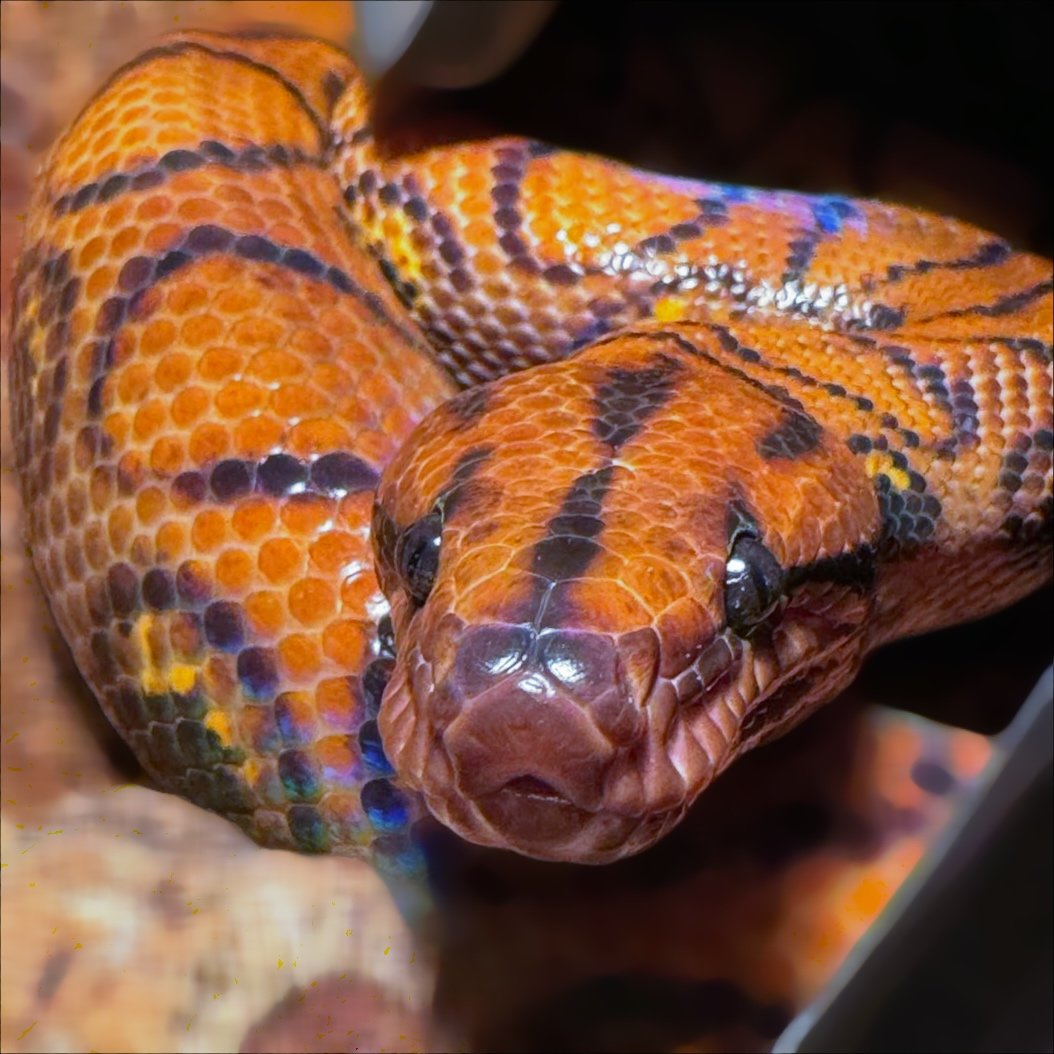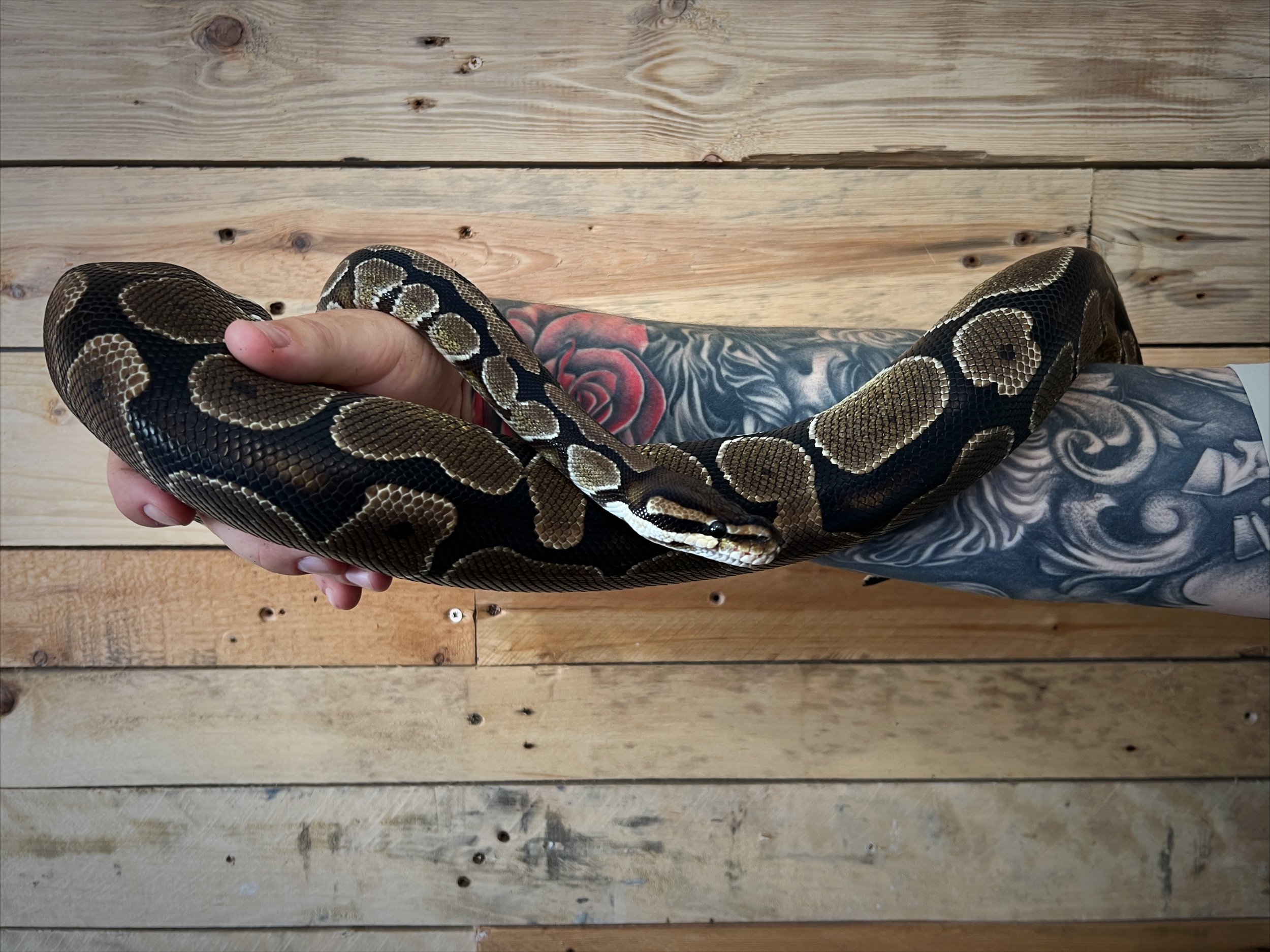MEET SOME OF OUR ANIMALS, AND FIND OUT SOME FUN FACTS ABOUT THEM!
SAFFY, OUR 11.5FT RETICULATED PYTHON
Saffy (short for Saffron) is our show-stopping reticulated python.
The reticulated python is one of the longest snakes in the world, and it can grow to be as long as a school bus! Saffy currently measures just over 11.5ft.
These snakes live in Southeast Asia, in places like jungles, grasslands, and near rivers. They are known for their beautiful, crisscross patterns on their scales, which help them hide from other animals.
Reticulated pythons are not poisonous—they catch their food by wrapping around it and squeezing gently until they can swallow it whole! They eat things like birds, small mammals, and even wild pigs.
Even though they are really big, they usually stay away from people. They need special care, and plenty of space!
FUN FACT: Saffy is so big, she needs two handlers at all times!
PUMPKYN, OUR BEARDED DRAGON
Pumpkyn is a bearded dragon: a cool-looking lizard that comes from the deserts of Australia. They get their name because they have spiky scales under their chin that puff up like a beard when they feel excited or scared! These "beards" also change colour, turning dark when they want to show off or defend themselves.
Bearded dragons, or "beardies," are gentle and friendly, which makes them popular pets. They love basking in the sun to warm up because, like all reptiles, they’re cold-blooded. In the wild, they eat all kinds of things—bugs, plants, fruits, and even small animals. They have sharp eyes and a long, sticky tongue to catch insects like crickets and worms (Pumpkyn’s favourites are morio worms!).
Beardies also communicate in funny ways, like waving their arms or bobbing their heads to talk to each other. They're curious creatures and can often be seen climbing rocks, branches, and exploring their surroundings.
FUN FACT: Pumpkyn is a special ‘hypo morph’, which means he’s vibrant orange and red.
STRETCH, OUR 7FT BOA CONSTRICTOR
Our stunning Stretch is an adult boa constrictor: a large, powerful snake that lives in tropical places like the rainforests of Central and South America. They can grow as long as a car and come in all sorts of colours, from browns and greys to red and green patterns that help them blend into their surroundings.
Unlike some other snakes, boas are non-venomous, which means they don’t use poison to catch their food. Instead, they wrap their strong bodies around their prey and give a tight squeeze, called constriction, which is how they got their name! They eat animals like birds, monkeys, or even wild pigs (although Stretch’s favourite meal is a jumbo rat).
Boas are great at climbing trees, slithering across the ground, and even swimming! These snakes are also quite patient hunters, waiting still and quiet for the perfect moment to catch their next meal. What’s amazing is that after a big meal, they might not need to eat for weeks or even months.
Even though they seem scary, boa constrictors are shy and would rather avoid humans. They're also important for keeping nature balanced by helping control animal populations.
FUN FACT: Stretch is actually over 7ft long - he’s just over 7’1”!
AXL, OUR YEMEN CHAMELEON
Yemen chameleons, also known as veiled chameleons, are colourful reptiles that come from the hot, dry deserts and mountains of Yemen and Saudi Arabia. These chameleons are famous for their incredible ability to change color! They use this skill to blend in with their surroundings, communicate with other chameleons, or show their mood. When they’re happy or calm, they might be green, but if they’re upset or excited, they can turn bright colors like yellow, orange, or even stripes!
Yemen chameleons have long, sticky tongues that can shoot out faster than a blink of an eye to catch insects like crickets and flies. Their tongues are sometimes even longer than their bodies! They also have super cool eyes that can move in two different directions at the same time, allowing them to look all around without moving their heads.
Another fun feature is the large crest, or "veil," on top of their heads, which looks like a little helmet and helps them stay cool in the sun. These chameleons love climbing trees and bushes, and their special feet, with toes grouped together, help them grip branches tightly.
Though they may look like tiny dragons, Yemen chameleons are shy and would rather be left alone to explore. With their colour-changing skills and funny tongue tricks, they’re one of the most fascinating reptiles on the planet!
FUN FACT: We’ve had Axl since he was a few months old, and he’s probably the most spoiled chameleon on the planet.
INDIE, OUR AMBILOBE PANTHER CHAMELEON
Indie is the youngest of the Scaly Safari Crew, and is just a few months old. This means he’s not currently on the road with us, but he will be very soon.
Panther chameleons are amazing lizards that live in Madagascar, an island off the coast of Africa. They are famous for their ability to change the colour of their skin! This helps them communicate with other chameleons, stay safe from predators, and even show how they're feeling.
Panther chameleons come in lots of bright colors, like red, green, blue, and yellow, depending on where they live. They also have big, funny-looking eyes that can move in different directions, letting them look for food and watch for danger at the same time.
These cool lizards eat insects, catching them with their super long, sticky tongues that can stretch out faster than the blink of an eye!
FUN FACT: Panther chameleons have tongues that can be twice as long as their body! They use these incredible tongues to catch insects by shooting them out at lightning speed—faster than you can blink! The tongue is sticky at the tip, which helps grab their prey and pull it back into their mouth.
APOLLO, OUR BRAZILIAN RAINBOW BOA
Apollo is our beautiful Brazilian rainbow boa - super-friendly, and super-strong!
These stunning snakes are known for their shiny, colourful scales that seem to glow like a rainbow when light hits them. They live in the rainforests of South America, especially in Brazil, where they like to stay near rivers and wetlands.
Brazilian rainbow boas are not venomous, and they catch their food by gently squeezing it before swallowing it whole. They eat things like mice, birds, and frogs.
These snakes are usually calm and can grow up to 6 feet long, like Apollo. Because of their amazing rainbow shine and gentle nature, they are popular with people who love snakes, but they need special care to stay healthy and happy!
FUN FACT: Brazilian rainbow boas have tiny heat-sensing pits on their upper lips! These pits help them "see" heat, like a built-in thermal camera, allowing them to detect warm-blooded animals (like mice or birds) even in complete darkness. This makes them excellent nighttime hunters!
XANDER, OUR BLUE-TONGUED SKINK
Xander is a blue-tongued skink: an amazing lizard that has a very special feature—a bright blue tongue! When they feel scared, they stick out their tongue to surprise predators. It’s like their secret defense trick, because the sudden flash of blue can startle animals that might want to eat them.
These skinks come from Australia, New Guinea, and nearby islands, and they’re known for being gentle and friendly, just like bearded dragons. They have smooth, shiny scales, and their bodies are long and flat with short legs, which makes them look a bit like a lizard mixed with a snake!
Blue-tongued skinks are great at hiding, and they love to burrow under leaves, rocks, or in small tunnels. In the wild, they eat a bit of everything—bugs, fruits, plants, and even snails! They’re not picky eaters, and their powerful jaws help them crunch through tough food.
These lizards are also fun because they’re slow and steady movers, and they don’t get easily stressed. Blue-tongued skinks make good pets for this reason, and they can live for a long time, sometimes up to 20 years! With their funny blue tongues and curious nature, they’re one of the coolest reptiles around.
FUN FACT: Xander is extra-special because he’s an ‘axanthic’ morph; a black-and-white skink that’s considered to be one of the most beautiful skinks in the world.
THUNDER, OUR BLOOD PYTHON
Thunder is a blood python: short, thick snakes that get their name from their beautiful reddish-brown scales, which can look like the colour of blood.
They live in swamps and rainforests in Southeast Asia, where they spend a lot of time hiding in muddy water or under plants. Blood pythons are not venomous—they catch their food by squeezing it gently before eating it whole.
They eat animals like birds, rats, and other small creatures. Even though they are shorter than some other pythons, growing to about 5-7 feet long, they are very strong! Their calm nature and cool colours make them a favourite for snake lovers who know how to take care of them properly.
FUN FACT: Thunder’s name was inspired by a care home resident we visit regularly, who used to be a drummer in a famous band!
DOLLY, OUR TENREC
Dolly is a tenrec: a small, amazing animal that lives on the island of Madagascar and parts of Africa. These little creatures come in all shapes and sizes—some look like tiny hedgehogs, others like mice, otters, or even shrews! Tenrecs are famous for their variety, and there are over 30 different species of them.
Tenrecs are mostly insect-eaters, munching on bugs, worms, and sometimes even small frogs or fruit. They have a good sense of smell and use it to sniff out food as they explore the forests and grasslands.
Though they are small, tenrecs are tough little survivors. They can live in all sorts of habitats, from tropical rainforests to dry deserts, and some can even slow down their bodies to save energy during colder months!
With their spiky bodies, special whiskers, and ability to live almost anywhere, tenrecs are some of the most interesting and diverse animals in Madagascar!
FUN FACT: In her enclosure, Dolly has a little sand box that she uses to roll around in. This helps her exfoliate and clean her skin!
PRETZEL, OUR ROYAL PYTHON
Pretzel is a royal python: a beautiful snake that comes from the grasslands and forests of Africa. They get their royal name because ancient African rulers used to wear them as living jewelry! These snakes are known for their calm nature and their cool pattern of dark brown, black, and gold spots.
What makes royal pythons special is how they defend themselves. Instead of being aggressive, they curl up into a tight ball when they feel scared, tucking their head in the middle to stay safe. That’s why they’re also called "ball pythons."
Royal pythons aren’t venomous, so they catch their food, like small mice or birds, by wrapping around them and giving a gentle squeeze, called constriction. These snakes are also great at hiding and exploring. In the wild, they love to find little burrows or crevices to hang out in.
Even though they may look tough, royal pythons are actually gentle and shy, which is why they are one of the most popular pet snakes in the world. With their royal history, amazing patterns, and gentle behavior, royal pythons are truly one of nature’s coolest snakes!
FUN FACT: So we can watch him at nighttime, Pretzel has a camera in his enclosure (called ‘PretzelCam’!) - and every night, he knocks it down…just for a giggle!
OUR GIANT HISSING COCKROACHES
Our Giant Madagascan Hissing Cockroaches are always a showstopper, and never fail to entertain!
These cool insects, found on the island of Madagascar, are special because they make a hissing sound—just like a snake! They do this by pushing air out through little holes on their sides. Unlike other cockroaches, they don’t have wings and they’re not fast runners, but they’re great climbers and love to explore.
With their shiny, dark brown bodies and friendly nature, they’re harmless to humans and even help clean up forests by eating old leaves and plants. These cockroaches might look a little spooky, but they’re actually gentle giants of the insect world!
RIPA, OUR INDIAN ORNAMENTAL TARANTULA
Ripa (pronounced Ree-pa) is an Indian ornamental tarantulas: an amazing, colourful spider that lives in the trees of India’s forests. They are known for their beautiful patterns of white, black, and yellow on their legs and bodies, which make them look like little works of art!
These tarantulas are very fast and spend most of their time hiding in tree holes or behind bark, waiting for insects to come close. Even though they might look scary, they are shy and would rather run away than fight.
Indian ornamental tarantulas are great climbers and use their silk to build cozy homes in trees, not to catch food like other spiders. Their stunning colors make them popular with people who love spiders, but they are best left in the wild unless cared for by experts!
FUN FACT: Indian ornamental tarantulas are considered "Old World" tarantulas, which are known for their more defensive nature. Indian ornamental tarantulas, like other Old World species, have specialized venom and tend to be quicker and more aggressive if they feel threatened.
“the general”, OUR giant asian scorpion
Giant Asian scorpions are large, impressive scorpions that live in the rainforests of Southeast Asia. These scorpions are usually black or dark brown and can grow up to 8 inches long—about as long as a pencil! They have big, powerful pincers and a long, curved tail with a stinger at the end.
Even though their size and appearance might look scary, Giant Asian scorpions are actually pretty shy. They use their pincers to catch insects, spiders, and sometimes small lizards, but they only sting if they feel really threatened. Their venom isn't very strong, and it mostly helps them catch their food rather than harm larger animals.
One of the coolest things about these scorpions is that they glow under ultraviolet (UV) light! If you shine a special light on them at night, they turn a bright blue-green colour, which makes them look like something from another world.
Giant Asian scorpions spend most of their time hiding under rocks, logs, or burrowing in the ground to stay safe from predators. They’re nocturnal, meaning they come out at night to hunt when it’s dark and cooler.
With their glowing bodies, strong pincers, and nighttime adventures, Giant Asian scorpions are one of the most fascinating creatures in the rainforest!
FUN FACT: We’ve had The General since he was a tiny baby, and his favourite things to eat are mealworms.
OUR GIANT ORANGE-LEGGED CENTIPEDE
The giant orange-legged centipede is a super cool insect that lives in parts of Central and South America. It gets its name from its bright orange legs, which stand out against its dark body.
These centipedes can grow pretty big, sometimes as long as a ruler! They are very fast and use their many legs to scurry around looking for food, like insects and small animals. When they catch their prey, they use sharp claws to grab it, and they have a bit of venom to help subdue it.
Even though they might look a little scary, giant orange-legged centipedes are more interested in hunting than bothering people. They are great at hiding in dark, damp places like under rocks or in leaf piles!
FUN FACT: While a giant orange-legged centipede's bite can be painful and cause swelling, it's unlikely to kill a human (although it is possible!). Their venom is powerful enough to stun smaller prey, but it’s generally not deadly to people. The bite can cause redness, swelling, and pain, similar to a bee sting, but it usually isn't life-threatening. However, if someone has a severe allergic reaction to the venom, they might need medical attention. It's always best to admire these fascinating creatures from a safe distance!


